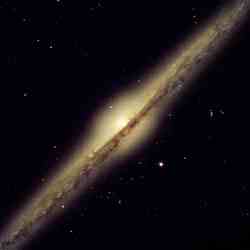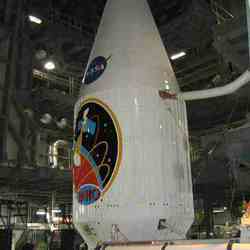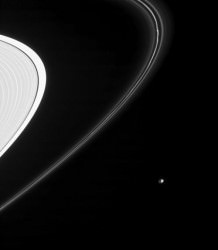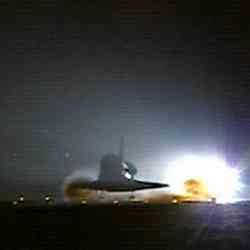
Discovery resting on the runway at Edwards Air Force Base. Image credit: NASA Click to enlarge
The Space Shuttle Discovery is home after a 14-day, 5.8 million-mile journey in space. The mission included breathtaking in-orbit maneuvers, tests of new equipment and procedures, a first-of-its-kind spacewalking repair, and virtual visits with two heads of state.
Commander Eileen Collins and the crew of the STS-114 mission, Jim Kelly, Charlie Camarda, Wendy Lawrence, Steve Robinson, Andy Thomas and Soichi Noguchi of Japan, landed at Edwards Air Force Base, Calif., at 8:12 EDT this morning.
“We have had a fantastic mission,” Collins said shortly after the crew disembarked from the Shuttle. “We brought Discovery back in great shape. This is a wonderful moment for us all to experience.”
Discovery’s mission, the first of two Return to Flight test missions following the 2003 Columbia accident, was one of the most complex space flights in NASA history. The crew flawlessly executed its to-do list.
After an on-time lift-off from KSC on July 26, the crew tested new capabilities and techniques developed over the past two-and-one-half years to inspect and possibly repair the Space Shuttle in orbit. Collins guided Discovery through an unprecedented back flip maneuver as it approached the International Space Station. The maneuver allowed the Station crew to snap high-resolution photos that added to the wealth of new data mission managers used to ensure Discovery was in good shape to come home.
“It’s going to be hard to top this mission,” NASA Administrator Michael Griffin said. “Everywhere you look, there’s nothing but outstanding success.”
Robinson and Noguchi, with the help of crewmates, completed three spacewalks. The astronauts repaired one Space Station Control Moment Gyroscope and replaced another. Their efforts put all four of the Station’s gyros back into service. They also tested new repair techniques for the Space Shuttle’s heat-shielding outer skin and installed equipment outside the Station.
When two thermal protection tile gap-fillers were spotted jutting out of Discovery’s underside, astronauts and other experts on the ground pulled together to devise a plan to prevent the protrusions from “tripping the boundary layer,” causing higher temperatures on the Shuttle during atmospheric re-entry. Ground controllers sent up plans to the Shuttle-Station complex for Robinson to ride the Station robotic arm beneath the Shuttle and, with surgical precision, pluck out the gap-fillers. Work on the Shuttle underbelly had never been tried before, but with Thomas coordinating, Lawrence and Kelly operating the robotic arms, and fellow spacewalker Noguchi keeping watch, Robinson delicately completed the extraction.
Discovery’s astronauts and the Station crew, Russian Sergei Krikalev and American John Phillips, transferred more than 12,000 pounds of equipment and supplies to the Station. Discovery returned about 7,000 pounds of Station material back to Earth.
The crew got phone calls from two world leaders. President George W. Bush and Japanese Prime Minister Junichiro Koizumi offered congratulations and appreciation for all the astronauts’ hard work.
Commander Collins and the crew also paid tribute to the fallen astronauts of Columbia, as well as others who gave their lives for space exploration.
Over the next several weeks, engineers will process data from STS-114, the first of two test missions for the Space Shuttle. Teams are already at work looking into why a large piece of foam fell off the External Tank during ascent. NASA managers have committed to understanding why the foam came off the tank, and remedying it if necessary, before clearing the next Space Shuttle Return to Flight test mission, STS-121, for flight.
The Discovery astronauts will spend the next few days undergoing medical checkouts, reuniting with their families, and returning to Houston. In about a week, after undergoing preparations at Edwards, Discovery will be ferried back to NASA’s Kennedy Space Center, Fla., atop a modified Boeing-747 aircraft.
For more about the Return to Flight mission, visit:
http://www.nasa.gov/returntoflight
Original Source: NASA News Release









